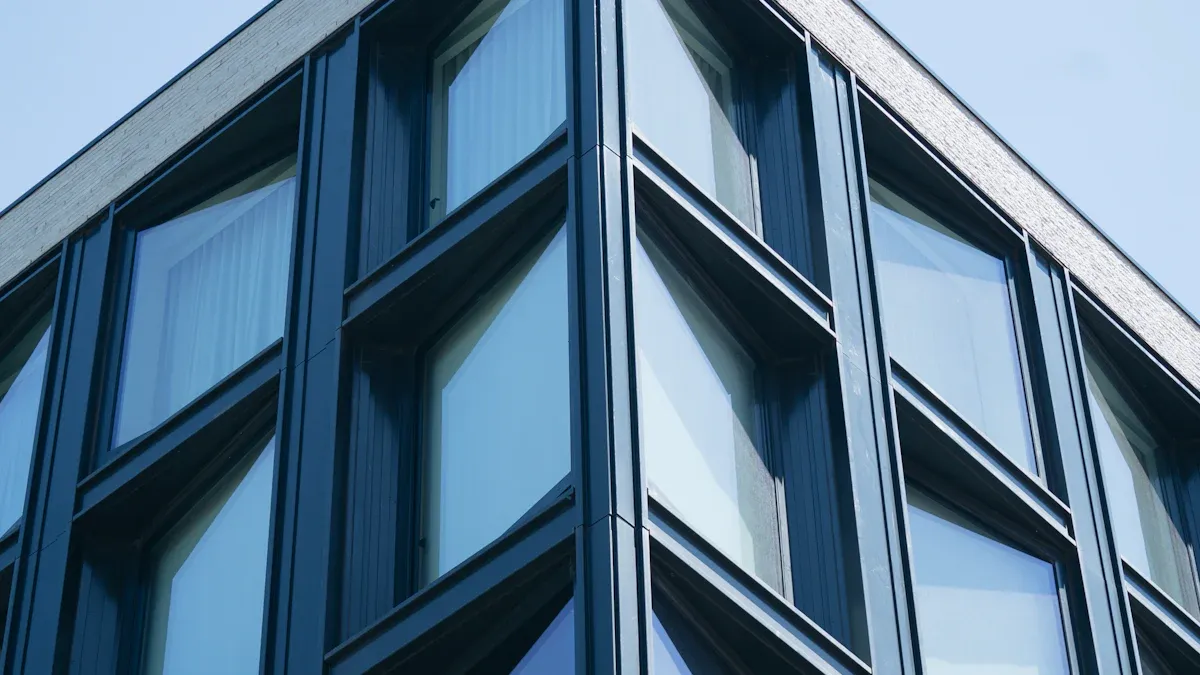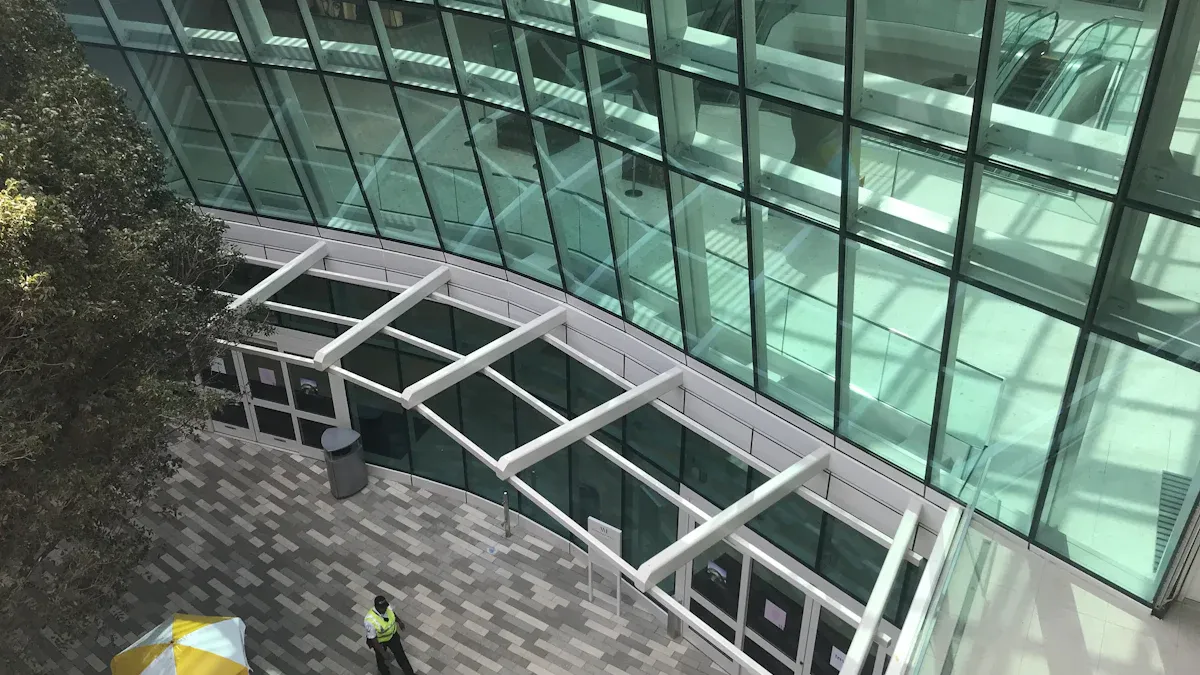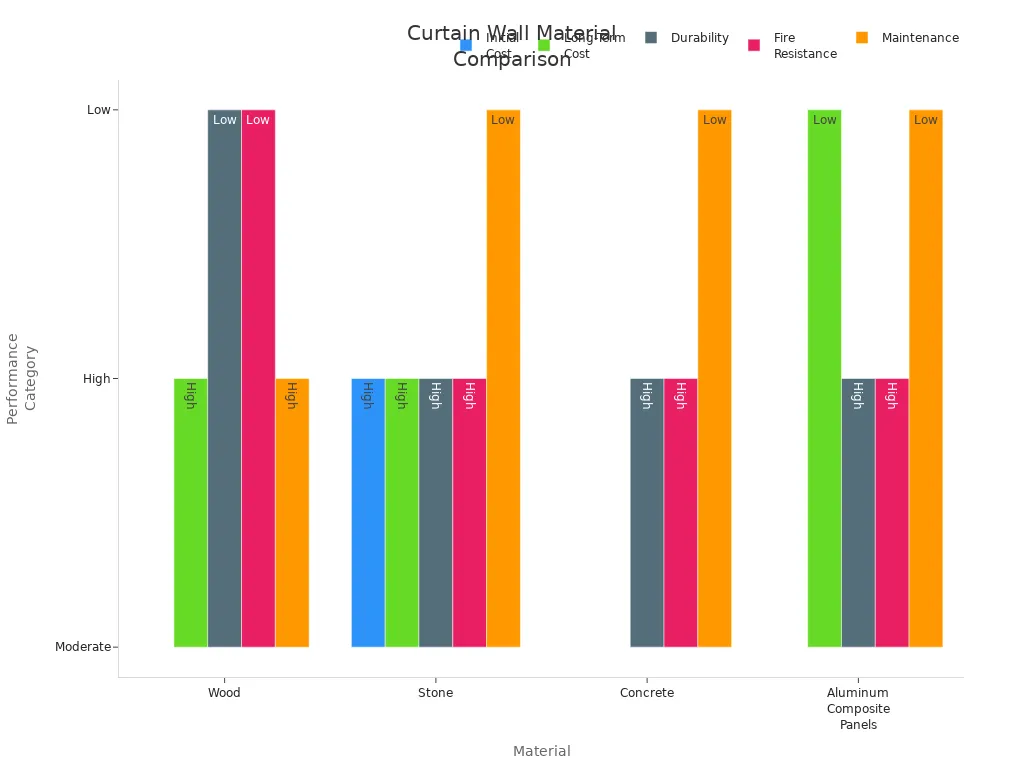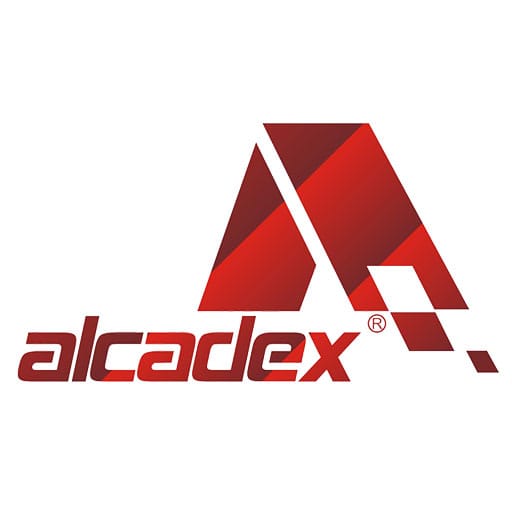
03 Sep Best ACP Thickness for Curtain Wall Construction
Table of Contents
The best ACP thickness for curtain wall construction is at least 4mm. Most building projects use 4mm panels or thicker for outside walls. These panels help protect against strong winds and impacts. Builders sometimes use 3mm panels for small or short buildings. But 3mm panels work better inside buildings. Tall towers often need 5mm or 6mm panels. Each panel should have an aluminum skin that is at least 0.50mm thick. This makes the panels work well and last longer.
Key Takeaways
Use ACP panels that are at least 4mm thick. The aluminum skins should be 0.50mm thick. This makes curtain walls strong and safe.
Pick thicker panels like 5mm or 6mm for tall buildings. These panels can handle strong winds and bad weather.
Choose panels with PVDF or fluorocarbon coatings. These coatings protect against sun, rain, and pollution. They also help lower maintenance needs.
Think about local rules, building height, and the environment. This helps you pick the right ACP thickness for the best results.
Use 4mm panels to balance cost and durability. These panels are strong, easy to install, and last a long time.
ACP Thickness Recommendations
Standard Sizes
Manufacturers make different sizes of aluminum composite panels for curtain walls. These sizes help builders pick the right panel for each job. The most common ACP thicknesses are:
Panel widths are usually 1220mm, 1250mm, or 1600mm. Builders can also ask for custom sizes if needed. The aluminum skin on each side can be 0.50mm, 0.40mm, or 0.30mm thick. Most curtain wall projects use panels with a 0.50mm skin on both sides. The aluminum is often from the 3000 or 5000 alloy series. These alloys make the panels strong and long-lasting.
Tip: Panels with a fluorocarbon resin coating last longer. They also protect better against bad weather than other coatings.
Minimum Requirements
Curtain wall systems must follow strict rules for safety and performance. Industry experts and top manufacturers suggest these minimums for ACP thickness:
Application Type | Minimum Total Thickness | Minimum Aluminum Skin Thickness | Recommended Alloy Series | Coating Type |
|---|---|---|---|---|
Curtain Wall (Exterior) | 4mm | 0.50mm (each side) | 3000, 5000 | Fluorocarbon resin |
Interior Use | 3mm | 0.21mm (each side) | 1100, 3003, 5052 | Polyester/Other |
For curtain wall construction, ACP thickness should be at least 4mm.
Each aluminum skin should be at least 0.50mm thick.
The aluminum must meet the GB/T 3880 standard.
Most builders use the 3000 or 5000 series alloys for more strength.
Fluorocarbon resin coatings give extra protection from UV rays and tough weather.
These rules help panels stand up to wind, impacts, and tough weather. Builders should always check local rules and project needs before picking an ACP thickness.
Performance Factors
Wind Load
Wind load is very important in curtain wall design. Engineers figure out wind pressure to know how thick panels should be. ASTM E 330 is the rule for testing curtain wall systems. Panels must handle high wind pressures for 10 seconds. These pressures can be plus 100 to 105 pounds per square foot or minus 90 pounds per square foot. Tests check if panels bend or break when stressed. Builders use thicker or stronger panels for strong winds. This helps stop panels from bending too much. The ACP thickness must fit these needs to keep buildings safe. Wind load math helps engineers pick the right panel thickness.
Note: Wind load math keeps buildings safe and stops big damage.
Durability
Durability depends on the panel quality and its coating. ACP panels with good PVDF coatings last 15 to 20 years. PVDF coating uses fluorocarbon resin to block UV rays, acid, alkali, and pollution. Makers often give a 15-year warranty for these panels. Panels thicker than 4mm with aluminum skins at least 0.5mm work best. Cleaning and checking panels often helps them last longer. Most curtain wall panels need little care if put in right. Roofing panels can last 30 to 50 years, but curtain wall panels face harder weather and last 15 to 20 years.
🛡️ Panels with thicker aluminum skins and good coatings do better against weather and pollution.
Building Types

Low-Rise
Low-rise buildings have one to four floors. These buildings do not get as much wind as tall ones. Builders use 3mm or 4mm panels for these jobs. Lighter panels are easier to put up and cost less. Most low-rise buildings do not need extra support. The panels still keep out rain, sun, and small hits. Many schools, small offices, and stores use these panels.
Tip: In windy places, engineers may pick 4mm panels for more safety.
Mid-Rise
Mid-rise buildings have five to twelve floors. These buildings get more wind than low-rise ones. Builders usually use 4mm panels with a 0.50mm aluminum skin. The panels must follow local rules and pass wind tests. Mid-rise buildings are often in busy cities. They need panels that can handle pollution and weather changes. Hospitals, hotels, and apartments are often mid-rise buildings.
Common panel picks for mid-rise:
4mm thickness
0.50mm aluminum skin
PVDF coating for long life
High-Rise
High-rise buildings have more than twelve floors. These towers get strong winds and tough weather. Engineers suggest 5mm or 6mm panels for these jobs. The panels need a strong aluminum skin and a tough coating. High-rise buildings often use special panels for strict safety rules. The panels must pass wind, fire, and impact tests. Skyscrapers, office towers, and fancy hotels use these thick panels.
Building Type | Typical Panel Thickness | Aluminum Skin Thickness | Common Uses |
|---|---|---|---|
Low-Rise | 3mm – 4mm | 0.30mm – 0.50mm | Schools, Shops |
Mid-Rise | 4mm | 0.50mm | Hotels, Apartments |
High-Rise | 5mm – 6mm | 0.50mm | Towers, Skyscrapers |
🏢 High-rise buildings need panels that meet the best safety and performance rules.
ACP Thickness Factors
Environmental Conditions
Environmental factors are important when picking ACP thickness for curtain walls. Builders need to think about the weather in the area. Places with lots of rain, snow, or strong sun need panels that can fight rust and damage. Coastal places have salty air that can make metal rust. Mountain areas get cold and warm again, which can make panels crack. Desert buildings need panels that block strong sunlight.
Thicker ACP panels last longer in tough weather. For example, 6mm panels are stronger and stay good in bad weather. Good coatings like PVDF or PE help panels fight sun and dirt. These coatings also mean less cleaning is needed.
ACP Thickness | Characteristics | Suitability for Extreme Weather Conditions |
|---|---|---|
3mm | Lightweight, easy to shape | Not recommended for harsh climates |
4mm | Stable, rigid | Good for most buildings |
6mm | Strong, durable | Best for extreme weather |
🌦️ Builders should use thicker panels and strong coatings in hard climates. This keeps buildings safer and helps curtain walls last longer.
Installation Height
How high a building is changes what ACP thickness is best. Tall buildings get hit by stronger winds and more pressure. Engineers say thicker panels are better for tall buildings. Low buildings can use 3mm or 4mm panels for safety. Buildings in the middle work well with 4mm panels and strong aluminum skins. Tall towers need 5mm or 6mm panels to stop wind and weather damage.
Panel thickness should fit the building’s height and how much wind it gets. Thicker panels stop bending and breaking up high. Builders must check local rules before picking ACP thickness for curtain walls.
🏗️ Picking the right panel thickness for building height keeps people safe and makes curtain walls last longer.
Practical Considerations
Cost
Picking the right panel thickness changes how much you pay now and later. Builders look at 3mm, 4mm, and 6mm panels before choosing. Each one has its own price and way to install:
3mm panels are mostly for inside walls or signs. They cost less but need extra support, like keels, if used on walls.
4mm panels are good for outside walls and curtain walls. Builders like them because they are flatter and harder. You can put 4mm panels right on the wall. This costs more at first but you do not need as much extra support.
6mm panels are used in tall buildings or tough places. There is not much price info for 6mm panels, but thicker panels usually cost more because they use more material and must be stronger.
Panel prices change with thickness, aluminum layer, and coating. For example, 3mm panels can cost 20 to 180 yuan per square meter. The price depends on how thick the aluminum is and who makes it. Builders must think about saving money with thin panels but needing more support and getting less strength.
💡 Picking 4mm panels for curtain walls is a good balance. They are not too expensive, easy to put up, and last a long time.
Maintenance
How much you spend on care depends on panel thickness and coating. Most people pick 4mm panels because they are not too pricey and last longer. These panels have PVDF coatings that help them stand up to bad weather and need less care.
Aspect | Key Insight |
|---|---|
Market Share by Thickness | 4mm panels are most popular because they balance price and strength. |
Cost and Maintenance | 4mm panels do not cost too much and PVDF coatings mean less work to keep them nice. |
Durability and Coatings | PVDF coatings make panels last longer and fight off bad weather. |
Panels with PVDF coatings block UV rays, acid, and dirt. This means you do not have to clean or fix them as much. Builders who use 4mm panels with good coatings pay less for care and get panels that last longer.
🧰 Cleaning and checking panels often helps them last longer, especially if they have strong coatings.
Compliance
Codes
Building codes and rules help decide how to use ACP panels. Most experts say outside curtain walls need panels at least 4mm thick. Each aluminum skin should be at least 0.50mm thick. These panels often use the 3000 or 5000 series alloys. These numbers come from what experts suggest, not always from official codes. In places like the US and Europe, codes may not list these numbers. Builders follow rules like ASTM B 209 for aluminum sheets. Local rules may also ask for fire safety and strength checks. Builders must look at project needs and local rules before picking ACP thickness.
Testing
Testing makes sure ACP panels are safe and good quality. Tests check many things, like how strong the material is and if it can stop fires. The table below shows test types and why they matter:
Test Category | Description / Purpose |
|---|---|
Aluminum Thickness | Checks aluminum layer thickness at several points. |
Coating Thickness | Measures coating thickness for consistency. |
Surface Pencil Hardness | Tests surface hardness to prevent scratches. |
Coating Gloss Deviation | Measures glossiness changes across the panel. |
Coating Flexibility | Bends panel to check for cracks or peeling. |
Coating Adhesion | Tests how well the coating sticks to the aluminum. |
Impact Resistance | Checks resistance to physical impacts. |
Chemical Resistance | Tests resistance to corrosion and chemicals. |
Bending Strength | Measures how much the panel can bend without breaking. |
Peel Strength | Tests the bond between aluminum and the core. |
Air and Water Infiltration | Checks for leaks under pressure. |
Structural Performance | Tests wind load resistance and deflection. |
Fire Resistance | Measures fire safety and burning characteristics. |
Tests use rules like ASTM E 283 for air leaks, ASTM E 331 for water, and ASTM E 330 for wind. Groups like UL, CE, and SGS do extra checks and give certificates. They look at fire safety, smoke, and other things. Certifications match rules like EN 13501-1 in Europe, ASTM E84 in the US, and GB 8624 in China. Builders should always check test reports and certificates before using ACP panels.
🏢 Good testing and certificates help keep curtain wall systems safe and following the rules.
Picking the right ACP thickness keeps curtain walls safe and strong. Experts say you should use panels that are at least 4mm thick. Each side should have a 0.50mm aluminum skin. The table below shows what is important:
Factor | Recommendation |
|---|---|
Minimum Thickness | 4mm |
Aluminum Skin | 0.50mm each side |
Core Material | Mineral-filled for fire safety |
Coating |

How tall the building is and how strong the wind blows matter. Rules and codes also help decide which panels to use. Experts make sure the panels follow all rules and last a long time.
FAQ
What is the minimum ACP thickness for exterior curtain walls?
Most experts say you need at least 4mm thick panels. This thickness is strong enough for wind and weather. Thinner panels might not be safe or last long.
Why does aluminum skin thickness matter in ACP panels?
Aluminum skin thickness makes panels stronger and last longer. Skins that are 0.50mm thick bend less and get less damage. Thicker skins also help with fire safety and work better outside.
Can builders use 3mm ACP panels for curtain walls?
Builders do not use 3mm panels for outside curtain walls. These panels are better for inside walls or signs. Outside walls need thicker panels to be safe and handle strong winds.
How does building height affect ACP thickness choice?
Tall buildings get hit by stronger winds and more pressure. Engineers pick thicker panels like 5mm or 6mm for tall towers. Short buildings can use 3mm or 4mm panels, depending on local rules.
Do ACP panels require special coatings for outdoor use?
Yes, outdoor ACP panels need special coatings like PVDF or fluorocarbon resin. These coatings protect panels from sun, rain, and pollution. Good coatings help panels keep their color and look nice for years.


